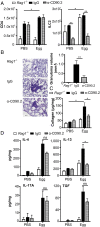IL-25 and type 2 innate lymphoid cells induce pulmonary fibrosis
- PMID: 24344271
- PMCID: PMC3890791
- DOI: 10.1073/pnas.1315854111
IL-25 and type 2 innate lymphoid cells induce pulmonary fibrosis
Abstract
Disease conditions associated with pulmonary fibrosis are progressive and have a poor long-term prognosis with irreversible changes in airway architecture leading to marked morbidity and mortalities. Using murine models we demonstrate a role for interleukin (IL)-25 in the generation of pulmonary fibrosis. Mechanistically, we identify IL-13 release from type 2 innate lymphoid cells (ILC2) as sufficient to drive collagen deposition in the lungs of challenged mice and suggest this as a potential mechanism through which IL-25 is acting. Additionally, we demonstrate that in human idiopathic pulmonary fibrosis there is increased pulmonary expression of IL-25 and also observe a population ILC2 in the lungs of idiopathic pulmonary fibrosis patients. Collectively, we present an innate mechanism for the generation of pulmonary fibrosis, via IL-25 and ILC2, that occurs independently of T-cell-mediated antigen-specific immune responses. These results suggest the potential of therapeutically targeting IL-25 and ILC2 for the treatment of human fibrotic diseases.
Keywords: cytokine; inflammation; innate response; therapy.
Conflict of interest statement
The authors declare no conflict of interest.
Figures





References
-
- Ley B, et al. A multidimensional index and staging system for idiopathic pulmonary fibrosis. Ann Intern Med. 2012;156(10):684–691. - PubMed
-
- Chiaramonte MG, et al. IL-13 is a key regulatory cytokine for Th2 cell-mediated pulmonary granuloma formation and IgE responses induced by Schistosoma mansoni eggs. J Immunol. 1999;162(2):920–930. - PubMed
Publication types
MeSH terms
Substances
Grants and funding
LinkOut - more resources
Full Text Sources
Other Literature Sources
Medical
Molecular Biology Databases
Miscellaneous

